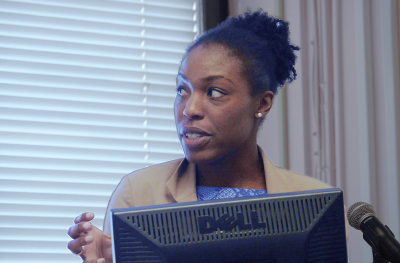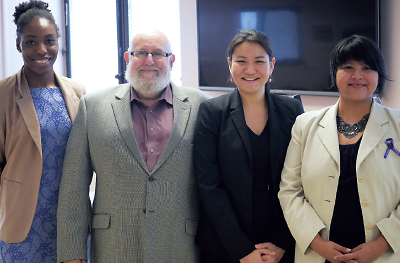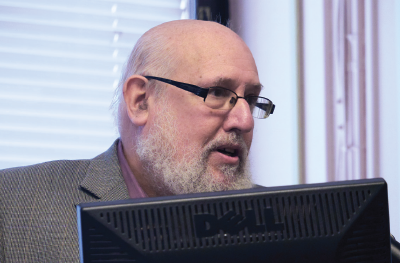Domestic Violence More Burdensome on Underserved Diverse Populations
Abstract
A diverse panel addresses the issue of the many manifestations of domestic violence in underserved populations.
Domestic violence knows no ethnic, geographic, or chronological boundaries, said speakers at a special program presented by APA’s Division of Diversity and Health Equity (DDHE) at Bellevue Hospital during IPS: The Mental Health Services Conference in New York on October 9.
Existing health disparities caused by race, ethnicity, religion, cognitive status, or gender have an increased burden on minorities and are only worsened by the presence of intimate partner violence (IPV), said Mayumi Okuda Benavides, M.D., an attending physician at New York Presbyterian Hospital-Columbia University Medical Center.

Victims of domestic violence may present with many somatic symptoms, especially among minority groups, says Obianuju Berry, M.D., M.P.H.
Often, such violence goes unreported by immigrants because of language difficulties, lack of knowledge of legal rights, and/or the absence of economic alternatives to remaining in an abusive relationship, said Benavides. Physical violence can induce depression, anxiety, and substance abuse and increase rates of suicidality.
Worse yet, she said, is the presence of syndemic illnesses—two or more interacting, synergistic epidemics, such as substance abuse, IPV, and AIDS.
“About 55 percent of women who are HIV positive have also experienced IPV,” she said. The combination can result in low birth weight for children of these women, increasing developmental and behavior problems, and creating a transgenerational perpetuation of health disparities.”
“In the United States, rates of IPV vary by ethnicity,” said Obianuju Berry, M.D., a child and adolescent psychiatry fellow at New York Presbyterian Hospital, who spoke about IPV in African immigrant populations. “There has been little formal study of that group, and many epidemiological surveys conflate black African and Caribbean immigrants with African Americans.”

From left are panelists Obianuju Berry, M.D., M.P.H., Mark Nathanson, M.D., and Mayumi Okuda Benavides, M.D., and moderator Margarita Guzman, J.D.
More than 1.5 million immigrants from Africa’s 47 countries have come to the United States in the last 20 years, she said. “They are educated but in poverty, with 90 percent having at least a high school education, but that does not translate to job opportunities in the United States.”
Cultural issues increase the acceptability of violence in this population, said Berry. Males are valued more highly than females, for example. Men are in charge of the family’s financial security, while women run the household, but a woman may be beaten if she fails at that task.
“In addition, women immigrants may find social isolation, prejudice, and language barriers upon moving to the United States,” she said. Leaving an abusive partner is difficult because it also means leaving one’s own community and identity.
Any interventions must be done in a culturally sensitive manner, said Berry. “Asking if a woman is ‘victim’ doesn’t work, but inquiring about specific symptoms, like ‘sadness’ or ‘crying’ are more likely to elicit useful information.”

Physical, emotional, and financial abuse of older people may not be immediately visible, and competent individuals have the right to make bad decisions, says Mark Nathanson, M.D.
Finally Mark Nathanson, M.D., addressed abuse among another marginalized, underserved population—the elderly.
The typical elderly victim of abuse is a woman living in social isolation and in physical and mental decline, said Nathanson, an attending physician at New York Presbyterian Hospital and director of the geriatric fellowship program at Columbia University and the New York State Office of Mental Health.
“The typical abuser is a family member who has substance abuse or mental health problems, a controlling personality, and is under some financial, emotional, or marital stress,” he said.
One complicating problem regarding the elderly is that if they retain decisional capacity, they have the right to make bad decisions and to refuse help from adult protective services, he said.
When such cases come to the attention of clinicians, they can begin by developing good written documentation, encouraging individual and group counseling of victims and abusers, and linking patients to community resources like adult day care programs or support groups. Recourse to the legal system may be a final step, if necessary.
Over the longer term, educational programs for caregivers, health care providers, and the public as well as changes in government policies may reduce abuse of the elderly, said Nathanson. “A multidisciplinary team approach can improve life for this group.”
In the second half of the program, representatives from a range of community support organizations in the New York area discussed the services they provide to domestic violence victims. The speakers included Margarita Guzman, J.D., executive director of the Bronx Family Justice Center; Vilma Torres, L.C.S.W., director of Safe Horizon at the Bronx Family Justice Center; Deirdre Lok, J.D., assistant director and general counsel at the Harry and Jeanette Weinberg Center for Elder Abuse Prevention at the Hebrew Home at Riverdale; and Hayley Carrington-Walton, Ph.D., program director of HELP-ROADS, a nonresidential family safety program. ■
Information about APA’s Division of Diversity and Health Equity can be accessed here.



